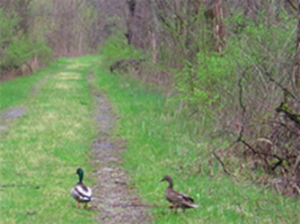Spring Creek Canyon Trail
By Gary Thornbloom
Hiker

A parula warbler’s raspy call hung in the treetops above me as I began to hike along Spring Creek heading upstream from Fisherman’s Paradise and into Spring Creek Canyon toward Rock Road four and one half twisting miles in the distance.
Fisherman’s Paradise supports a world-renowned trout fishery, and while it is well known to fishermen, the hike upstream long remained inaccessible to local hikers. This is because, although sections of the canyon were open to the public, others were owned by Rockview State Correctional Institute and had been closed to the public since 1925.
But in 2011, the area was transferred to a management coalition and is jointly managed for public use by multiple state agencies, Pennsylvania State University, and Benner Township. Keystone Fund grants played a role in this transfer.
The towering limestone cliffs upstream from Fisherman’s Paradise are repeated again and again further upstream. Steep canyon walls and running water rarely fail to captivate people, and here the experience is readily accessible. The cliffs are beautiful, with the stark bare rocks and rock layers that add to the setting. They have also helped to protect the canyon and provided niches for rare and endangered plant and animal species that can be found there. The narrow valley and the sound of the stream effectively screen the noise of nearby highways.
Spring Creek runs clear and cold, and is fed, as its name indicates, by the many springs along its course. The trail is a walker’s delight. Each meander of the stream is an invitation to new discoveries. The riparian environment is perfect for turtles, and the numerous insects the wary trout depend upon. A wide variety of trees, bushes, ferns, and wildflowers adds additional interest. The path, much of which follows Fish Commission access roads, makes for easy, pleasant walking. This, along with the gentle sound of the stream, is an ideal setting to lose yourself in a contemplative walk.

The fish hatchery, a research station, and Rockview buildings scattered along the stream make it impossible to think of this as wilderness. The invasive species of multi-flora rose, honeysuckle, Russian olive, and wild mustard are also reminders that the area has been impacted by human activities. The impacts are there, but so is the potential for reclaiming a beautiful small corner of Centre County.
As dramatic as the cliffs, in their own way, are the wildflowers. American ginger, bloodroot, squirrel corn, rue anemone, the emerging umbrellas of may apple, and both yellow and purple violets were some that I saw on my recent hike. Spring Creek Canyon conceals these many small and wonderful gems. The annual Mother’s Day Wildflower Walk that ClearWater Conservancy has led for the past couple of decades is a chance for people to experience the numerous wildflowers in Spring Creek Canyon.
The rim of the canyon offers scenic vistas of the mature hardwood forest that cloaks many sections of the canyon walls. Some of the mature forest lacks regeneration of trees that a healthy forest would have. Overbrowsing by deer has eliminated the nursery that should be present. Instead invasive mustard carpets the forest floor. Fields, both under cultivation and some reclaimed by brush, extend from Benner Pike to the rim of the canyon. The fields contain reservoirs of invasive plants. Farming the fields would include the threat of pesticide use. And the fields, by their irregular edge, result in a fragmented forest. All of these factors are threats to the long-term health of the canyon.
Reforestation would enhance the recreational experience of anyone visiting the area. On the day I was there a group of fishermen from Vermont wished local residents well in their efforts to protect Spring Creek Canyon.

